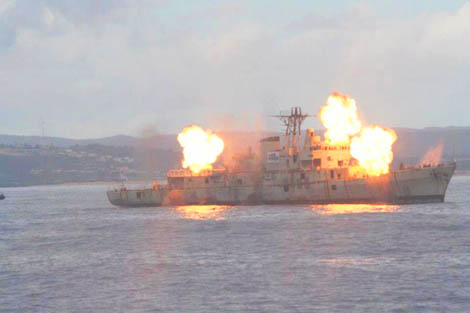 “5, 4, 3, 2, 1, fire”, said Rear Admiral Nunes Teixeira on the radio, in unison with Luís Sá Couto. Milliseconds later, about two miles offshore, explosions lit up the gray, autumnal sky, punching holes in the corvette's hull to let in water.
“5, 4, 3, 2, 1, fire”, said Rear Admiral Nunes Teixeira on the radio, in unison with Luís Sá Couto. Milliseconds later, about two miles offshore, explosions lit up the gray, autumnal sky, punching holes in the corvette's hull to let in water.
The ship went down, straight down, and ended up completely submerging. A little more than a minute and a half after the fire order, the old corvette was already under the water of the Algarve sea, thus starting the project's implementation «Ocean Revival».
After the old corvette was sunk in the morning «Oliveira and Carmo», in the afternoon, at 16:05 pm, the operation was repeated again, this time for the patrol ship «Zambezi». From the controlled explosions until the ship disappeared completely from sight, about two and a half minutes passed.
The sinking operations were accompanied either at sea, by vessels placed outside the security perimeter, or on land, from the balcony of the Hotel Alvor, located right in front of the sinking area.
Here, in addition to the fact that what was happening could be monitored with naked eyes, binoculars were available to guests and everything was accompanied by cameras, one of them equipped with a powerful 600 mm telephoto lens, which recorded in every detail the operations at around two miles from the coast, showing the images on a television screen, around which most people have gathered.
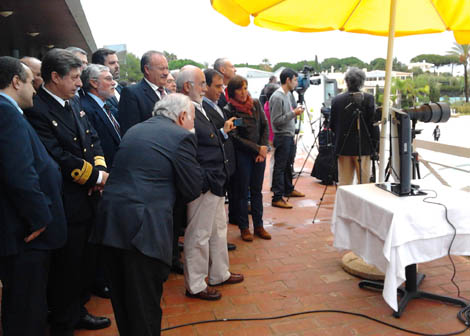
Rear Admiral Nunes Teixeira, representative of the Chief of Staff of the Navy, told the Sul Informação that the sinking of the two ships has to do with the «Navy's position of preserving two naval units in the middle where they have always been, the sea», giving continuity to «the Navy's cultural policy of preserving its heritage». In other words, he added, this time the ships were not "sold for scrap", as was the practice until now. "This marks a turning point," he guaranteed.
Luís Sá Couto, from the company Subnauta, founding member, with the Chamber of Portimão, of the Musubmar Association, which promotes the project to increase underwater tourism through the sinking of four old ships of the Portuguese Navy, was a man visibly relieved.
«Everything went well, the first two ships are already at the bottom and the indications I have are that they are fine. For me, the feeling is one of relief», guaranteed the entrepreneur. "The corvette descended nobly," he added, alluding to the fact that the first ship to be sunk, in the morning, had gently submerged in the calm waters of the sea. The same would happen again in the afternoon with the “Zambezi” patrol, although, in this case, the bow rose a little more during the sinking.
Sá Couto stressed that "what took place today in a minute and a half took eight months of preparation work", which included removing all potentially polluting materials from the ships, placing 220 tons of concrete to balance them, preparing the explosions, among many other jobs and bureaucracies. And it took another five years of the project, as the president of the Portimão Chamber would comment later.
After the sinkings, Navy divers went downstairs to check if everything was as planned and the first news was positive. "If the Navy gives us the official ok, on Thursday we'll go diving there with a group." And the first two ships in this underwater park will then be open to diving, the project promoters hoping that this area in front of Prainha becomes a strong attraction for a niche in the tourist market that until now had little expression in the Algarve.
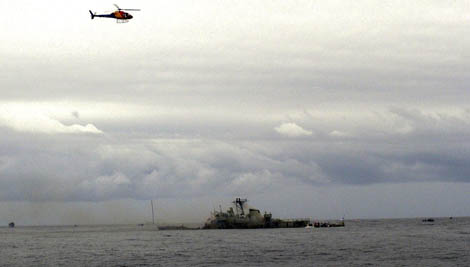
Manuel da Luz, mayor of Portimão, who accompanied the operation on land, underlined that this was “a very important moment, following a process that took five years to materialize and that crossed three central Governments”.
The sinking of the first two ships, underlined the mayor, "clearly indicates that this is an irreversible process." Now it is necessary to «promote the project» to attract to the municipality of Portimão «this new market niche. Diving tourism is not seasonal, it takes place throughout the year, and has a great impact on both the local and regional economy».
But the submersion of the two ships, which now rest on the bottom of the sand and ditch, at a depth of 35 meters, is not the end of this project. To complete it, the remaining two ships need to be sunk.
Luís Sá Couto announced that the cleaning of these former Navy units has already started, but this time in the Alfeite (Tejo estuary), because the Portimão shipyard docks are not big enough to accommodate them. "We hope in March to sink one of these ships and in May or June the other." And so, at the bottom of the sea, a short distance off the coast of Portimão, the largest purposely sunk fleet in the world will become open to divers. This is, in fact, the main point of interest of the «Ocean Revival» project: «the invitation we make to divers is that they come here to visit a squad of the Portuguese Navy», stressed Sá Couto.
«These four ships will have to be visited on several dives and, moreover, over the course of six, seven years, they will be in constant evolution, namely in terms of the marine life they will attract. The divers who go there now will want to return, because when they return they will see a different ship», he added.
To give substance to the first phase of the «Ocean Revival» project, Sá Couto guarantees that he has already invested close to one million euros. But for everything to materialize – with the sinking of the other two ships, the purchase of a hyperbaric chamber to be installed at the Hospital de Portimão and the creation of a museum center on land – the project will reach three million euros.
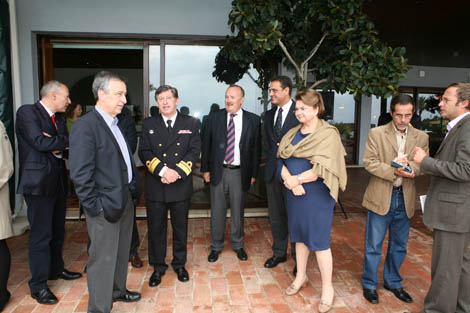
And will this investment ever be recovered? the journalists wanted to know. «This is not an investment, it is a donation made to the country», guarantees Sá Couto.
However, he admits that his diving company - Subnauta -, as well as all the others already existing in the Algarve and those that might be created due to the estimated increase in the number of divers, hope that the creation of the underwater park will actually serve attraction for this new niche in the tourist market.
Indifferent to these issues of money and tourism, biologist Miguel Neves dos Santos, a researcher at the Portuguese Institute of the Sea and the Atmosphere (IPMA), highlighted the interest of sunken ships as artificial reefs that could increase marine life, namely fish species of interest to commercial fishing.
With these sinkings, which join the existing concrete reefs, «the Algarve will have one of the largest artificial reefs in the world», in a total area of 43 square kilometres», in other words, 4300 football fields.
As soon as the suspended materials settle and the Navy divers confirm that the safety conditions are in place, on Thursday the first tourist divers will visit the two submerged ships. And it may be that there they will already find some more curious fish.
Note: most of the photos are by Filipe da Palma/Câmara Municipal de Portimão
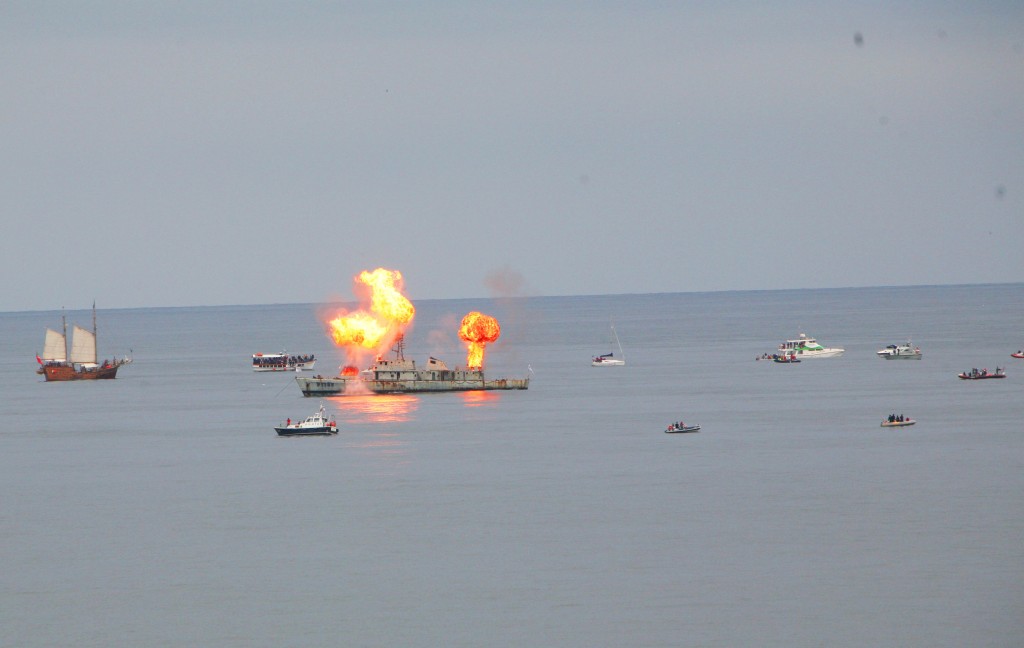
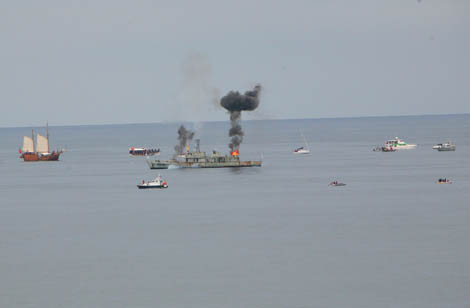
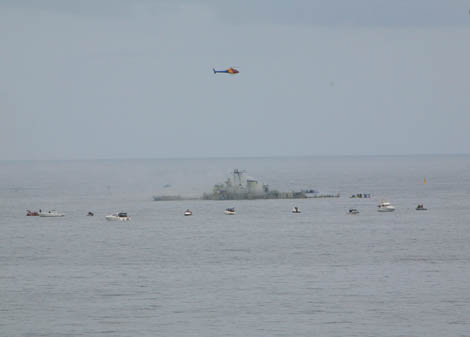
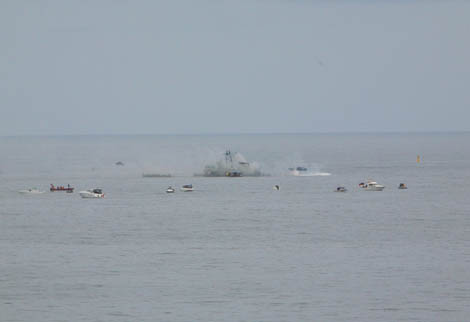
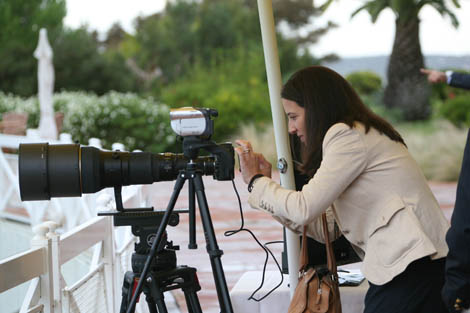
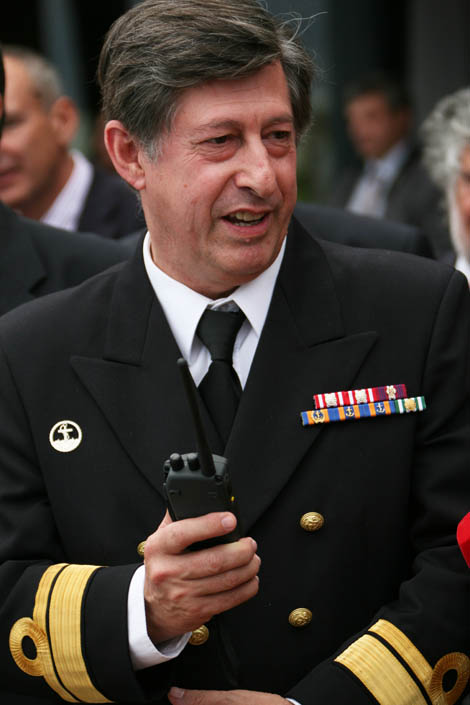


















Comments